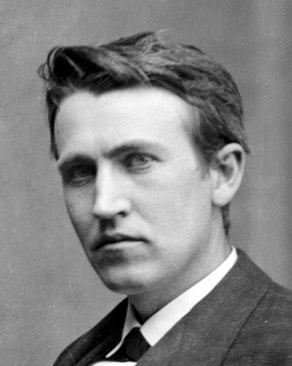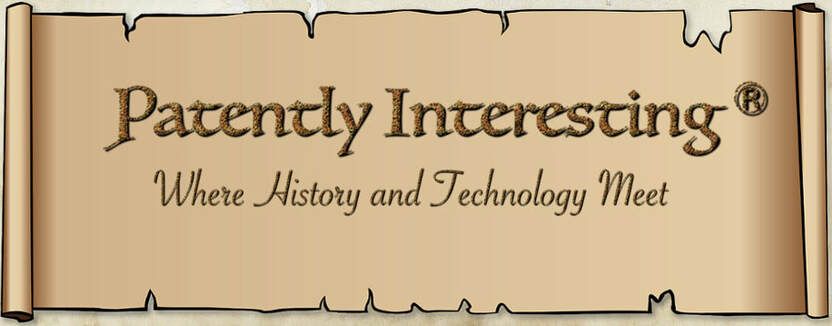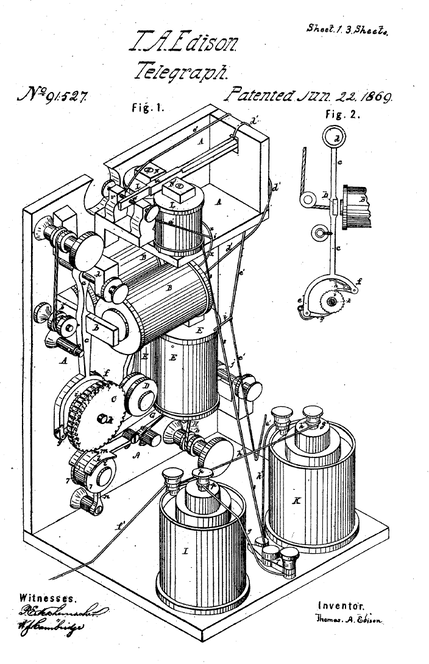 Thomas Edison in 1877
Thomas Edison in 1877
On February 17, 1869, Thomas Alva Edison filed a patent application for an "Improvement in Printing Telegraphs". The patent application would issue as U.S. Patent No.: 91,527 on June 22 of the same year. The patent application for the '527 patent was only the second patent application Edison had ever filed. He had filed his first patent application less than three months earlier, on November 28, 1868, for an "Electric Vote Recorder". While Edison's first printing telegraph invention was not important in and of itself, it was important because it was the first time Edison received money for one of his inventions and it led to a much more important invention that Edision would make in 1871: an improved ticker tape.
Edison had become interested in telegraphy early in his life. At the age of 16, Edison was able to persuade a telegrapher, James Mac Kenzie, to teach him telegraphy. Mac Kenzie likely acquiesced, at least in part, because Edison had saved the life of his three-year-old son the year before by snatching him from the path of an oncoming box car.
After learning telegraphy from Mac Kenzie, Edison embarked on a career as a telegrapher. The beginning was a bit rocky though. Edison was fired from his first job, at Port Huron, Michigan, after he blew up the telegraph office. Ever curious, Edison had decided to experiment with the batteries used to run the telegraph equipment by taking the acid out of the batteries and mixing it with other substances, which resulted in a violent explosion. It would not be the first time Edison lost a job for conducting unauthorized experiments.
After the mishap in Port Huron, Edison hit the rails and worked at a series of telegraph offices in the midwest and south. At each office, Edison would conduct experiments when he was not working. These experiments often led to Edison being dismissed from his job. In one of his last telegraph jobs, at the Western Union office in Louisville, Edison was once again attracted to the sulfuric acid in the batteries of the telegraph equipment. He drew out a large amount of the acid into a glass carboy (demijohn) for one of his experiments that he was conducting. While carrying the carboy, Edison accidentally dropped it on the floor, causing it to break and spread acid all over the floor. The acid ate through the floor and dripped onto the expensive furniture and rugs of a bank located in an office below, destroying them. Needless to say, Edison was fired for this transgression.
After the debacle in Louisville, Edison went to Boston in 1867. It was here that Edison made his first two inventions, the electric vote recorder and the printing telegraph. Edison developed the vote recorder on his own accord, thinking it was a good idea. Unfortunately for Edison, the invention failed to make any money because there was no demand for it. Edison, however, was paid $250 to develop the printing telegraph because there was a need for such a device. From this experience, Edison learned a valuable lesson that he carried with him through his inventing career: don't invent something people don't want.
Edison had become interested in telegraphy early in his life. At the age of 16, Edison was able to persuade a telegrapher, James Mac Kenzie, to teach him telegraphy. Mac Kenzie likely acquiesced, at least in part, because Edison had saved the life of his three-year-old son the year before by snatching him from the path of an oncoming box car.
After learning telegraphy from Mac Kenzie, Edison embarked on a career as a telegrapher. The beginning was a bit rocky though. Edison was fired from his first job, at Port Huron, Michigan, after he blew up the telegraph office. Ever curious, Edison had decided to experiment with the batteries used to run the telegraph equipment by taking the acid out of the batteries and mixing it with other substances, which resulted in a violent explosion. It would not be the first time Edison lost a job for conducting unauthorized experiments.
After the mishap in Port Huron, Edison hit the rails and worked at a series of telegraph offices in the midwest and south. At each office, Edison would conduct experiments when he was not working. These experiments often led to Edison being dismissed from his job. In one of his last telegraph jobs, at the Western Union office in Louisville, Edison was once again attracted to the sulfuric acid in the batteries of the telegraph equipment. He drew out a large amount of the acid into a glass carboy (demijohn) for one of his experiments that he was conducting. While carrying the carboy, Edison accidentally dropped it on the floor, causing it to break and spread acid all over the floor. The acid ate through the floor and dripped onto the expensive furniture and rugs of a bank located in an office below, destroying them. Needless to say, Edison was fired for this transgression.
After the debacle in Louisville, Edison went to Boston in 1867. It was here that Edison made his first two inventions, the electric vote recorder and the printing telegraph. Edison developed the vote recorder on his own accord, thinking it was a good idea. Unfortunately for Edison, the invention failed to make any money because there was no demand for it. Edison, however, was paid $250 to develop the printing telegraph because there was a need for such a device. From this experience, Edison learned a valuable lesson that he carried with him through his inventing career: don't invent something people don't want.


